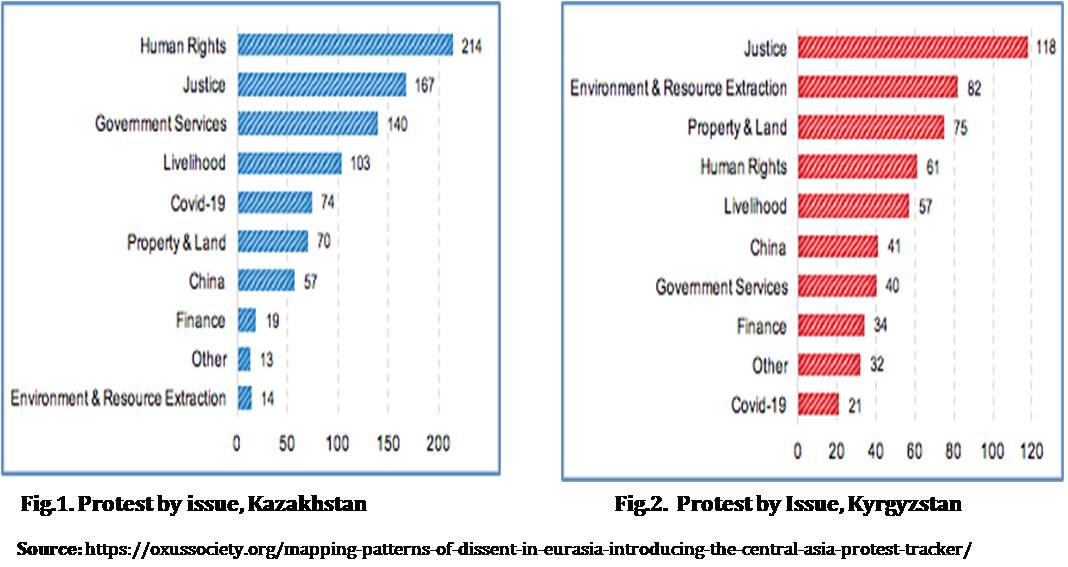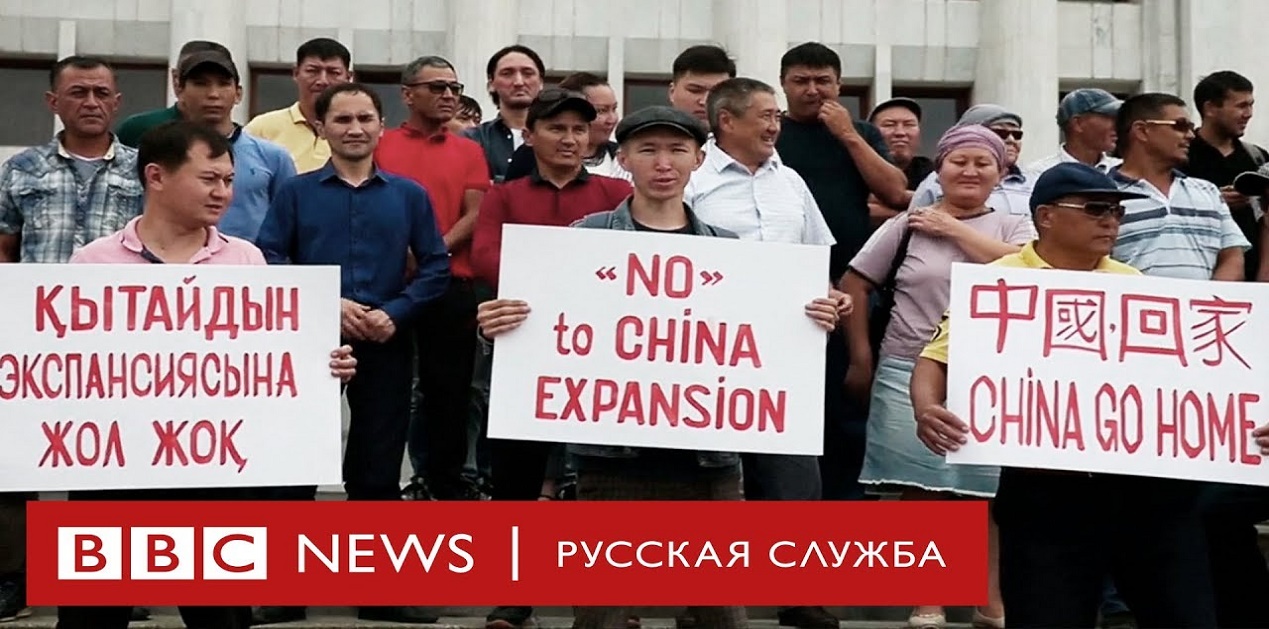Introduction
China's relation with its Central Asian neighbours has been complicated. Even though Beijing maintains good relations with most Central Asian governments, rising anti-Chinese sentiments among the local populace have proved challenging for its ambitions in the region.1 Central Asia is crucial for China's Silk Road Economic Belt (SREB), the overland segment of the One Belt One Road or Belt and Road Initiative (OBOR/BRI). The region serves as the natural land bridge connecting East Asia with Europe. Therefore the economic and infrastructural development of this region was vital for the success of BRI.2 Beijing's investment in Central Asia concerning BRI projects has proved to be detrimental in various aspects. Most prominently, it has created threat perceptions as some of the Central Asian economies owe now almost 50 percent of their external debts to China. And the Chinese investments have not contributed towards raising the living standards of the Central Asian population, thus fuelling anti-Chinese sentiments or Sinophobia.3
The Oxus Society for Central Asian Affairs, a research organization based in Washington, published a report mapping protests in the five Central Asian republics. The report categorised 981 incidents of dissent over a two and a half year span until August 2020.4 The Oxus Society's assessment also spotted a rising trend of China-related protests in the region by cataloguing 98 anti-China demonstrations.5 Besides one protest in Tajikistan, most anti-China protests occurred in Kyrgyzstan and Kazakhstan, where China is viewed with greater suspicion.6

Although demonstrations against Chinese penetration in Central Asia have been taking place since 2010, their intensity has increased considerably in recent years. These protests were centered mainly around grievances such as moving Chinese factories in the region, illegal Chinese immigrants, Kazakhs' and Kyrgyzs' detention in Xinjiang, and China's policy of leasing land, etc.7 Anti-China sentiment in Central Asia isn't just relegated to Kyrgyzstan, as there have been regular flare-ups of public outrage throughout the region as China's growing footprint there increases. In Kazakhstan, protests against China have become increasingly commonplace, with the causes of demonstrations ranging from the construction of new Chinese factories and power plants, the prospect of Chinese investors buying or leasing land, and the perceived environmental damage due to China moving into the low-grade industry.8
Causes Responsible for Emergence of Anti-China Sentiments
Historical
Historical
In Central Asia, there is widespread prejudice against China, mostly ingrained in the history of aggression embedded in folklore narratives and reinforced by the lasting memory of Soviet-era propaganda. China has long been looked at with trepidation due to the history of confrontation with the Central Asian nomads.9 Adopting the existing narratives to the contemporary context, people generally tend to construe the increasing Chinese presence in Central Asia as a well-thought-out move of an old predatory neighbour looking to subjugate and exploit the region for its benefit. Some Central Asian experts also argue that China seeks to benefit from its economic dominance in Central Asia by turning the region into a 'dumping ground' for Chinese goods and 'a source of natural resources.' The same framework history books in the region used to describe colonialist policies of the Russian Empire. As is evident from increasingly frequent anti-Chinese protests in Kyrgyzstan and Kazakhstan, civil society has a serious concern over Chinese expansion.10
Moving of Chinese Industries and Businesses
Kazakhstan saw a series of protests against Chinese policies of exploitation in several cities in recent months. From big cities such as Nur Sultan, Almaty, and Shymkent to Aktobe and Karaganda, people gathered on the streets, calling for their subsiding dependence on Beijing. These protests started with a mass gathering to demonstrate against the construction of Chinese factories in Zhanaozen in Kazakhstan's Mangystau region. As per the agreements between Kazakhstan and China, Beijing plans to build more than fifty factories in Kazakhstan, with a total investment of 27 billion USD. These investments aggravate the public fears of increased corruption and dependence on Chinese FDI.11
Further, it would also add to the city's already high unemployment rate. Although Zhanaozen is known for oil production, the protestors claim that Chinese factories mainly hire Chinese workers, leaving the Kazakhs unemployed.12 Similar incidents have frequently taken place in Kyrgyzstan as well, where the public protested against the Chinese being given the mining rights.
Illegal Chinese Immigrants
In Kyrgyzstan, the conflict between Kyrgyz and Chinese workers is routine. In August 2019, 500 Kyrgyz villagers entered a mine operated by a Chinese company and fought with Han workers. Subsequently, 20 Chinese workers were hospitalised after the brawl. Chinese workers also marry Kyrgyz women in large numbers, which is another issue fuelling the anti-Chinese sentiments. Even though only sixty such marriages were recorded from 2010 to 2018 but it has caused serious concerns.13 Although the actual numbers seem low, fear of an influx of Chinese immigrants is also prevalent in Kazakhstan and Kyrgyzstan. From 1995 to 2014, around 93,000 people emigrated from China as part of an official Kazakhstan repatriation program. Only eighty of them were Han Chinese, and the rest were ethnic Kazakhs.14
Policy of Leasing Land
The protests stem from the 2016 land reform plans, which allowed for Kazakh land to be sold or leased at auctions and rented in concessions lasting about twenty-five years. The threat of further Chinese expansion paved the way for widespread protests, eventually forcing the Government to suspend the reform. Ever since, Kazakh nationalist and the anti-Chinese sentiments have become common amongst the country's general public.15
Detention of Ethnic Kazakhs and Kyrgyz in Xinjiang
Beside Uyghurs, the Chinese crackdown was expanded to include other Turkic Muslims; namely, the 1.5 million Kazakhs and more than 200,000 Kyrgyz who live in Xinjiang. Kazakhstan and Kyrgyzstan's local population started asking as to why their governments were not raising this issue more forcefully in officials' meetings with China. However the respective Governments remained silent on the issue.16
Trans-boundary linkages between Central Asia and Xinjiang play a vital role in the Central Asian population raising their voice against Chinese Repression of Ethnic minorities. The protests in Kazakhstan and Kyrgyzstan against China are mainly due to family ties across the border with Xinjiang where their kin and brethren are ill-treated. Due to increasing Chinese crackdown on ethnic minorities in Xinjiang, many Kazakhs and Kyrgyz have lost contact with their relatives across the border. China's cordial relations with Central Asian governments have intensified their fear.17
Central Asian Governments' Response to the Sinophobia
Recent public protests and blistering anti-China sentiments have been largely ignored and, in some cases, suppressed by the authorities as inter-governmental relations and bilateral trade between China and Central Asian countries are quite strong. China's considerable investments and trade ties have constrained the Central Asian states to criticise Beijing. Presently, China holds a significant economic influence over almost all five Central Asian countries. China-Central Asia trade almost doubled to around USD 40 billion between 2007 and 2018. China has also surpassed Russia and the EU as the major trading partner of Central Asian republics.18
Additionally, China has provided 14.7 USD billion in foreign direct investments (FDI) and undocumented unconditional loans to underdeveloped Central Asian countries as of 2018. Since China does not provide official data on its international lending, it is difficult to find out the exact amount of loans provided to Central Asian countries. However, a study was conducted by Sebastian Horn and his colleagues to find out China's overseas lending. This study was published in June 2019 as the Kiel Working Paper No. 2132 titled 'China's Overseas Lending.' Their findings estimated that Kyrgyzstan owed around 30 percent of its GDP, while both Turkmenistan and Tajikistan owed around 15 percent of their GDP to China as of 2017.19 These figures have been increasing annually. The region's economic dependence on China is so overwhelming that Central Asian countries' governments generally pay no attention to these protests and interrelated issues.
While Kyrgyzstan and Tajikistan are heavily indebted to China and Turkmenistan almost dependent on China for its export revenue, countries like Kazakhstan and Uzbekistan are well off compared to these states. However, China's SREB has presented an opportunity for underdeveloped Central Asian countries to get much-needed investments. Also, given the military and economic might of China, Central Asian countries generally avoid antagonising Beijing. These countries rely on back channels diplomacy rather than making public comments to convey their concerns to China on its ethnic minority policy in Xinjiang. Still, China's dependence on building strong relationships with Central Asian countries' governments and expanding mutual economic interactions with the region have not been sufficient to mitigate the belligerent public sentiments.20
References
- Connor Dilleen, ‘Central Asia’s simmering anti-China sentiment’, The Strategist, ASPI, 2 May 2019. https://www.aspistrategist.org.au/central-asias-simmering-anti-china-sentiment/
- Wade Shepard, ‘Another Belt and Road Project Bites The Dust as China’s New Silk Road Continues To Struggle’, Forbes, February 25, 2020. https://www.forbes.com/sites/wadeshepard/2020/02/25/another-belt-and-road-project-bites-the-dust-as-chinas-new-silk-road-continues-to-struggle/
- bid.
- Bradley Jardine, Sher Khashimov, Edward Lemon, Aruuke Uran Kyzy, ‘Mapping Patterns of Dissent in Eurasia: Introducing the Central Asia Protest Tracker’, Report, Oxus Society for Central Asian Affairs, https://oxussociety.org/mapping-patterns-of-dissent-in-eurasia-introducing-the-central-asia-protest-tracker/
- Ibid.
- Reid Standish, ‘From COVID-19 to China: Mapping the Changing Face of Dissent in Central Asia’, RFE/RL, October 01, 2020. https://www.rferl.org/a/from-covid-19-to-china-mapping-the-changing-face-of-dissent-in-central-asia/30868684.html?ltflags=mailer
- Ayjaz Wani, ‘Rising anti-Chinese sentiments in Kazakhstan’, ORF Expert speak, October 04 2019. https://www.orfonline.org/expert-speak/rising-anti-chinese-sentiments-in-kazakhstan/
- Wade Shepard, ‘Another Belt and Road Project Bites The Dust as China’s New Silk Road Continues To Struggle’, Forbes, February 25, 2020. https://www.forbes.com/sites/wadeshepard/2020/02/25/another-belt-and-road-project-bites-the-dust-as-chinas-new-silk-road-continues-to-struggle/
- Akbota Karibayeva, ‘Public Attitudes Toward China In Central Asia’, Special Report, Caspian Security And Politics Program (Cspp), May 11, 2020. https://www.caspianpolicy.org/special-report-public-attitudes-toward-china-in-central-asia/
- Ibid.
- Anastasia Temerko, ‘Anti-China Protests in Kazakhstan: Signaling the Slowdown of the Belt and Road Initiative?’ Risk Analysis & Insights, Atlas Institute for International Affairs, October 8, 2019. https://www.internationalaffairshouse.org/anti-china-protests-in-kazakhstan-signaling-the-slowdown-of-the-belt-and-road-initiative/
- Ibid.
- Bradley Jardine, ‘Why are there anti-China protests in Central Asia?’ The Washington Post, October 16, 2019. https://www.washingtonpost.com/politics/2019/10/16/why-are-there-anti-china-protests-central-asia/
- Ibid.
- Anastasia Temerko, ‘Anti-China Protests in Kazakhstan: Signaling the Slowdown of the Belt and Road Initiative?’ Risk Analysis & Insights, Atlas Institute for International Affairs, October 8, 2019. https://www.internationalaffairshouse.org/anti-china-protests-in-kazakhstan-signaling-the-slowdown-of-the-belt-and-road-initiative/
- Bruce Pannie, ‘Why Are Central Asian Countries Silent About China's Uyghurs?’ RFE/RL, September 22, 2020. https://www.rferl.org/a/why-are-central-asian-countries-silent-about-china-s-uyghurs-/30852452.html
- Reid Standish, ‘From COVID-19 to China: Mapping the Changing Face of Dissent in Central Asia’, RFE/RL, October 01, 2020. https://www.rferl.org/a/from-covid-19-to-china-mapping-the-changing-face-of-dissent-in-central-asia/30868684.html?ltflags=mailer
- Mohd. Adnan, ‘Rise of Anti-China Public Sentiments in Central Asia’ Blog, ICS, June 1, 2020. https://icsin.org/blogs/2020/06/01/rise-of-anti-china-public-sentiments-in-central-asia/
- Sebastian Horn, Carmen Reinhart and Christoph Trebesch, ‘China’s Overseas Lending’, Kiel Working Paper No. 2132, Kiel Institute for the World Economy, June 2019. https://www.ifw-kiel.de/fileadmin/Dateiverwaltung/IfW-Publications/Christoph_Trebesch/KWP_2132.pdf
- Mohd. Adnan, ‘Rise of Anti-China Public Sentiments in Central Asia’ Blog, ICS, June 1, 2020. https://icsin.org/blogs/2020/06/01/rise-of-anti-china-public-sentiments-in-central-asia/
(The paper is the author’s individual scholastic articulation. The author certifies that the article/paper is original in content, unpublished and it has not been submitted for publication/web upload elsewhere, and that the facts and figures quoted are duly referenced, as needed, and are believed to be correct). (The paper does not necessarily represent the organisational stance... More >>
Image Source: https://i.ytimg.com/vi/n7yT7OumTAA/maxresdefault.jpg











Post new comment